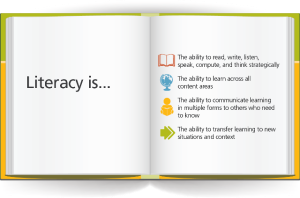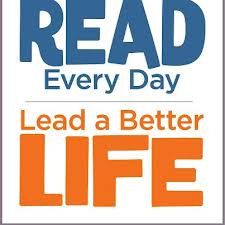[My own work regarding the role of high school English teachers in literacy development.]
The conceptual basis for literacy is no longer static. For multiple reasons, it is an increasingly difficult task for students and teachers to comprehend and master; yet, as teachers engage the broader spectrum of communicating meaning through different mediums, via traditional means or technological advances, students will engage all the more naturally and find relevance all the easier to grasp. This is to say “conceptions of literacy continue to expand in multiple directions, moving far beyond former emphases on reading comprehension and writing ability” (Shoffner, De Oliveira, & Angus, 75).
The role of the secondary English teacher is not that of mere literacy. Literacy is a means to the greater end of socialization and positive integration with society. It also helps teachers when developing their lesson objectives. The goal is not just to understand what happens in a book or to learn some grammar, but how to use and apply the learning experience toward something greater. How can literacy be applied to a greater purpose?
 To read a book simply for the purpose of reciting the plot and naming the main characters on a test is a severe disservice to the book and its author. The traditional realm of literacy does include comprehension of informational text and literature, but to stop there would neglect speaking, listening, writing, and language (as outlined in Arizona’s Common Core Standards). One could boil it down to the classic trivium of grammar, logic, and rhetoric, each building off the other as students are given the opportunity to practice proper language conventions, argumentation skills, and the art of persuasion.
To read a book simply for the purpose of reciting the plot and naming the main characters on a test is a severe disservice to the book and its author. The traditional realm of literacy does include comprehension of informational text and literature, but to stop there would neglect speaking, listening, writing, and language (as outlined in Arizona’s Common Core Standards). One could boil it down to the classic trivium of grammar, logic, and rhetoric, each building off the other as students are given the opportunity to practice proper language conventions, argumentation skills, and the art of persuasion.
And this, here, introduces the rub, the element of discomfiture for the uninitiated teacher. Proper practice means students are called to express themselves through language, and expression introduces opinions, and opinions can differ from student to student. Conversations regarding the issues of diversity and current issues are generated, and the skills required for facilitating these discussions (Ruiz, Many, Aoulou, 26). This free expression extricates the classroom from the static, and delivers it into the bounteous, albeit unpredictable, realm of the dynamic. Bieler is optimistic that the purpose of the secondary English classroom, with its focus on the expression of language (i.e.: rhetoric), is likely to sow the seeds of compassion (Bieler, 10).
Inexperienced teachers might not see how free expression might lead toward compassion, as the freedom of expression inevitably results in a strong form of differing opinions. These uncomfortable moments, disagreements, or even conflicts are actually a desired aspect of literacy development, because it provides opportunities for students to talk, read, listen, and write with patience and rigor to a point where students are forced to resolve the dissention in a just and compassionate manor. Not that everyone is right or that there is no right answer, but that we still have to be able to work together as a society even as those differing opinions exist.
To put it another way, not all conflicts can be resolved in one sitting, and some opinions run parallel to each other, never able to intersect; even so, we still have to be able to work together, to care, to help, and to love. As an English teacher “we are often talking about the drama around the choices that human beings make – and the consequences of those choices” (Bieler, 10). The faults of characters in literature encourage us to discover real-life examples in which tragedy could be avoided and violence is prevented in order to not re-create those mistakes. Essentially, the secondary English classroom is the perfect environment to practice decision-making and conflict management. Literature, in all its intrigue, plot, drama, conflict, foil and character flaw is driven by human nature, and the sooner students learn to recognize human nature at work, the more knowledgeable they will be about handling it in their own lives. We are talking about how to foster a classroom full of mutual respect and self-control.
This will affect lesson objectives and the angles to take in dialogue. This will buck at the perfectly sanitized, politically correct, walking-on-eggshells, carefully-worded classroom of today’s publicly funded schools. Not that conflict and argument is encouraged, but that students are allowed to open up and hash out the expressions of their heart now, in the learning environment of a classroom, when they can practice how to communicate well and how to implement conflict management. It may involve stress, but it is far better now than in the so-called ‘real world.’ Therefore, teachers should grade the quality of student work on social interactivity and relational understanding as much as on the quality of student thinking and performance.
With this in mind, Beiler encourages teachers to ask the question, “Does our current choices in literature unwittingly shape a worldview that expects and perpetuates violent behavior?” Not that we exclude such books, but that we should be aware of the patterns of behavior that our choices represent. Our choices need to include instances of compassion, companionship, philanthropy, and the like.
However, another justification hindering the re-emergence of this understanding of literacy is the difficulty presented in assessing such things as empathy and community building in an era of high-stakes testing (Beiler, 14). Some believe the answer is as simple as the very fact of participation and interpretation, regardless of what, exactly, students interpret from the input provided. A teacher interviewed by Shoffner, De Oliveira, & Angus would define literacy as referring “to the idea of being able to look at that text, whatever it is, and extract some sort of meaning from it…some sort of meaning, to me, is literacy” (81). This logic encourages teachers to give extra points for freestyle meaning-making, inventive thinking, and accepting multiple interpretations of a text; just so long as students contrive some sort of meaning to personally apply to the text.
 Unfortunately, this instills in the impressionable mind of our average student that statements about meaning are nothing more than feelings. C.S. Lewis addresses this danger directly, warning that this proposition will teach schoolchildren to believe “that all sentences containing a predicate of value are statements about the emotional state of the speaker” (15). It becomes meaningless to use literature toward an instructive end when students are doing nothing more than arguing opinions. Remember, the goal, as discussed above, is to promote inherently desirable values, traits which are universally acceptable and merit our approval.
Unfortunately, this instills in the impressionable mind of our average student that statements about meaning are nothing more than feelings. C.S. Lewis addresses this danger directly, warning that this proposition will teach schoolchildren to believe “that all sentences containing a predicate of value are statements about the emotional state of the speaker” (15). It becomes meaningless to use literature toward an instructive end when students are doing nothing more than arguing opinions. Remember, the goal, as discussed above, is to promote inherently desirable values, traits which are universally acceptable and merit our approval.
Therefore, as teachers prepare their lesson objectives, and consider that which is beyond the nuts and bolts of traditional literacy, we can clarify that they also need to move beyond that which is simply empty conversation about subjective meaning in a text. Literacy encourages specific values in society and challenges students to evaluate their emotional reactions to a text, a value, an opinion, or a fact, and consider whether such a reaction is meritorious or not, and whether the object of our reaction merits our approval or disapproval, reverence or contempt (Lewis, 25).
This is a mighty caveat for free expression; without this clarification classroom discussions become the same fluff as any other form of busywork. Students are certainly learning to express themselves, but toward a logical, reasonable end of fitting into the framework of society. “Education is that vast undertaking of passing on the wisdom and knowledge of one generation to another. It involves discovery, but also instruction; it is cultural transmission” (Perrin, 4).
 The goal for an educator never ends with the pure, raw facts. Rote learning is only a very small component of an effective classroom. For the secondary English teacher, literacy is likewise not so limited as to end with reading comprehension and writing skills. Literacy itself refers to so much more, so much, in fact, that it is being superseded by the goal of presenting and encouraging multiliteracies, whether in reference to reading mediums, traditional skills, or cultural, language, and social literacy.
The goal for an educator never ends with the pure, raw facts. Rote learning is only a very small component of an effective classroom. For the secondary English teacher, literacy is likewise not so limited as to end with reading comprehension and writing skills. Literacy itself refers to so much more, so much, in fact, that it is being superseded by the goal of presenting and encouraging multiliteracies, whether in reference to reading mediums, traditional skills, or cultural, language, and social literacy.
And even so, literacy is never the end in itself, but rather a means to an even greater end—that of compassion, discourse, respect, dialogue, mature relationships, and higher order thinking. That said, this promotion of certain values as a crucial aspect of literacy is making a claim toward that which exists beyond mere opinion and feeling or meaning-making. Of course, this includes the ability to pass state standards, advance to college (if desired), and pursue a career, but these are only the results, the byproducts of a greater whole.
References
Bieler, D. (2006). Changing the Subject: Building Critical and Compassionate Communities in English and English Education Classrooms. Penn GSE Perspectives on Urban Education, 4(1).
Lewis, C.S. (1974). The Abolition of Man.
Perrin, C. (2004). An Introduction to Classical Education: A Guide for Parents. Classical Academic Press, v.2.5.
Ruiz, A., Many, J., Aoulou, E. (2011). The Prevalence or Absence of Attention to Adolescent Literature in the Initial Preparation of Secondary Content Teachers. SRATE Journal, 20(2), 23-30.
Shoffner, M., De Oliveira, L., & Angus, R. (2010). Multiliteracies in the secondary English classroom: Becoming literate in the 21st century. English Teaching: Practice and Critique, 9(3), 75-89.



 Most books like these are from powerhouse authors who once disbelieved, and actually set out to disprove the gospel, and in so doing, discovered the supreme veracity of Scripture. The author of this book does admit to certain doubts, as all people do, but claims no such journey of discovery. Maybe I’m spoiled when it comes to apologetics because of such names as Lee Strobel, Josh McDowell, and J. Warner Wallace, who all have compelling testimonies to back-up their desire to seek objective evidence.
Most books like these are from powerhouse authors who once disbelieved, and actually set out to disprove the gospel, and in so doing, discovered the supreme veracity of Scripture. The author of this book does admit to certain doubts, as all people do, but claims no such journey of discovery. Maybe I’m spoiled when it comes to apologetics because of such names as Lee Strobel, Josh McDowell, and J. Warner Wallace, who all have compelling testimonies to back-up their desire to seek objective evidence.







